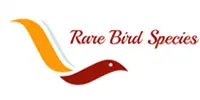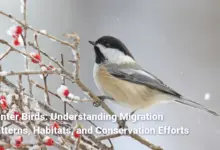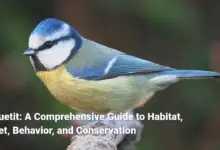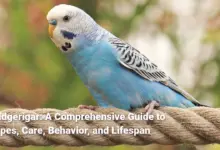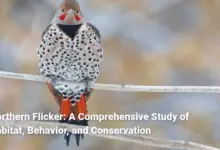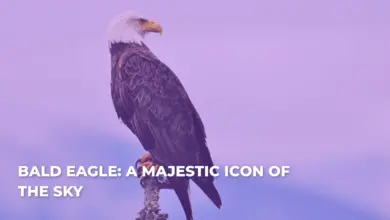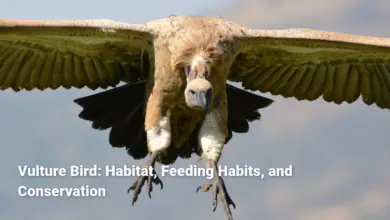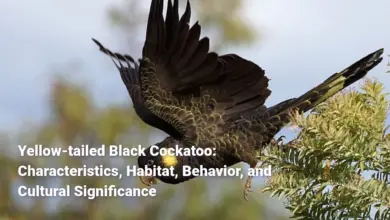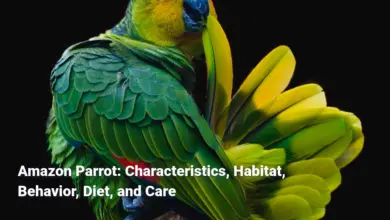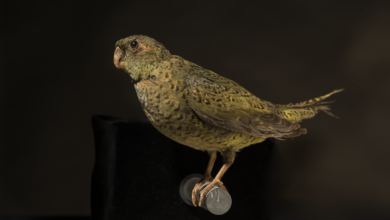Magpie Goose: Physical Traits, Habitat, Behavior and Conservation
A Comprehensive Look at the Magpie Goose’s Unique Characteristics, Natural Environment, and Conservation Efforts
Magpie Goose
The Magpie Goose (Anseranas semipalmata) is an intriguing waterfowl species that draws interest not just for its unique appearance but also for its ecological significance. Prominently found in various wetland habitats across northern Australia and parts of Papua New Guinea, this bird has become a vital subject of study for ornithologists, conservationists, and cultural anthropologists alike. Marked by its striking black and white plumage reminiscent of a magpie, its physical characteristics and behaviors provide a deep connection to its environment and the communities that depend on it. The magpie goose exemplifies the intricate balance of life in wetlands, showcasing the relationships between species and their habitats, and it plays a crucial role in the biodiversity of these ecosystems.
This article explores the magpie goose’s physical traits, habitat, behaviors, conservation status, and cultural significance. By examining its feeding habits, nesting behaviors, and challenges, we gain a deeper appreciation of its role in the environment and its importance to Indigenous Australians. Let us embark on a journey to uncover the many facets of the magpie goose.
Physical Characteristics of the Magpie Goose
The magpie goose boasts several distinct physical features that capture the attention of bird enthusiasts and casual observers alike. Resembling a living painting with its striking black and white contrast, it stands out among waterfowl. Its lavish plumage helps identify the bird, showcasing its adaptability to life in wetland environments.

First, let’s talk about its size and weight. The magpie goose generally measures 70 to 90 cm (27.6 to 35.4 inches) in length and has a wingspan of about 1.5 meters (5 feet). Males typically weigh 1838 to 3195 grams (4.1 to 7.0 pounds), while females weigh 1405 to 2770 grams (3.1 to 6.1 pounds). Its size makes it one of the larger waterfowl in its habitat, contributing to its dominant presence.
Now, let’s consider its coloration and distinctive features. The head and neck are predominantly black, contrasting sharply with its mostly white body. This striking coloration serves a functional purpose, aiding in camouflage from predators while foraging among grasses and aquatic plants. It possesses long, elegant necks and legs, features that not only add to its regal appearance but also enhance its ability to maneuver efficiently through both aquatic and terrestrial environments.
An important aspect of its physical traits is its unique feet structure. Unlike many waterfowl that have fully webbed feet, the magpie goose has partially webbed feet, allowing it to effectively navigate muddy wetlands and grasses. This adaptation gives it the agility to traverse through different terrains both in water and on land, such as perching on low branches or walking through the varied environments of its habitat.
Overall, the physical characteristics of the magpie goose paint a vivid picture of a species uniquely adapted to thrive in its ecological niche. With its combination of size, striking coloration, and specialized foot structure, it represents the wider diversity and adaptability found within the Anatidae family.
Size and Weight of the Magpie Goose
The size and weight of the magpie goose (Anseranas semipalmata) make it one of the more formidable birds in its habitat. They are a large species, characterized by robust bodies and long necks. Generally, adults measure between 70 to 90 centimeters in length (or approximately 27.6 to 35.4 inches) and boast a wingspan reaching around 1.5 meters (about 5 feet). Their impressive size not only allows them to navigate easily through their natural habitats but also serves to give them a distinct advantage against smaller predators.
When it comes to weight, male magpie geese typically range from 1838 grams to 3195 grams (approximately 4.1 to 7.0 pounds), while females generally weigh less, ranging between 1405 grams to 2770 grams (around 3.1 to 6.1 pounds). This difference in weight is not just a minor detail; it plays a critical role in their social structure and mating behaviors. Heavier males are often considered more attractive to females, which may influence breeding success.
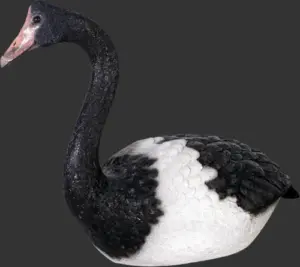
The size spectrum also plays a crucial role in the habitat selection of magpie geese. Larger individuals tend to require more substantial resources, thus favoring wetter areas that can support their feeding needs. The birds prefer wetlands rich in grasses and aquatic vegetation, where their size gives them an edge in foraging.
In summary, the magpie goose’s size and weight underline its adaptations to life in wetlands. The combination of a substantial wingspan and robust body lends itself well to a bird that must traverse and thrive in flood-prone environments. It serves as a reminder of the inherent beauty and function of physical attributes in aiding survival.
Coloration and Distinctive Features of the Magpie Goose
The magpie goose stands out with its striking black and white plumage, resembling a yin-yang symbol. Its black head and neck contrast with its glossy white body, providing camouflage in the dappled wetland sunlight and helping it evade predators.
One of the magpie goose’s most impressive features is its long, hooked bill, similar to that of carnivorous birds. This adaptation enhances its feeding efficiency, allowing it to easily pluck leaves, stems, and seeds from water plants and access various food sources. The bill’s unique structure defines its appearance and demonstrates nature’s elegant functionality.
In addition to its color and bill structure, the magpie goose has long, stout legs that are distinctly yellow-orange. These long legs allow for ease of movement through its preferred habitats, which range from shallow waters to grassy floodplains. An interesting feature is the partially webbed legs, which help the magpie goose swim and walk, making it a versatile forager.
Another notable aspect of the magpie goose is its pronounced dome on the top of the head, a distinctive trait particularly visible in males. This dome accentuates its silhouette and contributes to its overall memorable appearance. As a collective, these features paint a picture of a bird that is not only beautiful but intriguing in its adaptations and role within its ecosystem.
The magpie goose’s coloration and features reveal its survival strategies, habitat preferences, and social interactions. Examining these traits helps us appreciate the complex relationships within wetland ecosystems and the avian species that inhabit them.
Unique Feet Structure of the Magpie Goose
The magpie goose has a unique foot structure that enhances its mobility and feeding. Unlike many waterfowl with fully webbed feet, it has partially webbed feet, an evolutionary adaptation that helps it thrive in wetland habitats.
The magpie goose has longer, less webbed toes compared to other aquatic birds, offering greater nimbleness. This design enhances flexibility, allowing it to maneuver easily through mud, grasslands, and shallow waters, much like a dancer gliding across a stage.

This foot adaptability also aids in its feeding habits. The magpie goose primarily forages on vegetation, such as aquatic plants, grasses, and seeds. The elongated toes help the bird efficiently pluck food from the ground and water’s surface. Foraging in this way provides a broader range of food choices, helping to sustain the bird through varying environmental conditions.
Additionally, the partially webbed feet allow the magpie goose to engage in a behavior commonly observed among tree-dwelling species. This adaptation allows the magpie goose to perch on low branches or walk on floating vegetation, expanding its foraging capabilities beyond shallow waters. This versatility highlights the species’ resourcefulness and its specialized evolution in response to habitat conditions.
The magpie goose’s unique foot structure reflects evolutionary priorities suited to its diverse wetland habitat. Its feet, adapted for versatility, showcase nature’s ingenuity in evolving species to meet environmental demands.
Habitat of the Magpie Goose
The habitat of the magpie goose is crucial to its life cycle, affecting its feeding, nesting, and migration. It thrives in wetland environments across northern Australia and parts of Papua New Guinea, including floodplains, marshes, and swamps, where it finds abundant food and secure nesting sites.
Wetlands act as a natural buffet for the magpie goose, offering aquatic plants, grasses, and invertebrates. During the wet season (November to April), these areas become biodiversity hotspots. Magpie geese gather in large numbers in flooded regions rich in food, providing essential resources for both adults and their young.
The magpie goose is widely found across northern Australia, especially in the Northern Territory. It thrives in areas like Kakadu National Park’s floodplains, where seasonal flooding creates varied wet and dry habitats. These conditions are crucial for providing food and shelter, underscoring the species’ dependence on specific environments.
During the dry season, the magpie goose becomes nomadic, moving to areas with remaining water. This adaptability is crucial for survival and highlights their reliance on changing habitats. Their use of agricultural and urban areas for foraging also shows their resourcefulness and flexibility with seasonal changes.
The habitat of the magpie goose is closely linked to its life patterns, including feeding and nesting, highlighting the interdependence between species and their environment. Understanding these habitats underscores the critical role of wetlands in supporting biodiversity, particularly for specialized species like the magpie goose.
Natural Environment
The natural environment of the magpie goose (Anseranas semipalmata) is a vibrant tapestry woven with rich ecosystems, marked by wetlands, floodplains, and marshes that serve as their primary habitats. These areas are particularly abundant in northern Australia and parts of New Guinea, showcasing the intricacies of biodiversity that involve various flora and fauna.
Typically, magpie geese thrive in shallow, semi-permanent wetlands rich in sedges and grasses. These wetlands have become crucial during the wet season, which sees significant increases in water levels, transforming the landscape into a fertile ground for aquatic vegetation. The combination of seasonal flooding and nutrient-rich soils supports a plethora of food sources, including aquatic plants and seeds that are essential for the magpie goose’s diet.
Additionally, the geese prefer habitats that provide a mosaic of vegetation structures, from reeds and rushes to open grasslands. This variety enhances their foraging opportunities and offers essential cover from potential predators. The wetlands’ overall health affected by factors such as rainfall patterns and human activities is crucial for sustaining not only the magpie goose but also numerous other species dependent on these ecosystems for survival.
The magpie goose is also known to exhibit opportunistic behavior in its natural environment. During seasonal transitions, particularly the dry season, these geese are known to migrate into agricultural fields, urban landscapes, and other altered habitats. This adaptability allows them to capitalized on available resources that may not be natural to their ecology but provide sustenance during harsher periods.
Moreover, understanding the natural environment’s changing dynamics is vital for conservation efforts aimed at ensuring the sustainability of magpie goose populations. Changes wrought by climate variability, urban development, and agriculture can significantly influence the available resources and habitats, making protective measures essential for the survival of the species long-term.
Overall, the magpie goose’s natural environment represents the complexity and interconnectedness of ecological systems. By analyzing the various elements that contribute to their habitat selection, we gain insight not only into their biology but also into the challenges presented by changing environmental conditions.
Distribution in Australia and Papua New Guinea
The distribution of the magpie goose (Anseranas semipalmata) encompasses the wetlands of northern Australia and southern New Guinea, where its population primarily flourishes. This geographical range showcases the adaptability and resilience of the species as it navigates various wetland environments rich in resources.
In Australia, the greatest concentrations of magpie geese can be observed in the Northern Territory, particularly around floodplains critical for breeding and wintering. For example, large populations can be found in Kakadu National Park, where seasonal changes create an abundant food supply. Their distribution also aligns with regions subject to flooding during the wet season, which effectively creates favorable conditions for breeding.
The magpie goose’s range extends beyond the Northern Territory, stretching to include the eastern regions of Queensland and parts of New South Wales. Interestingly, these birds have shown adaptability by expanding into coastal areas, where they are frequently sighted near estuaries and coastal wetlands. This movement reflects their ability to exploit various habitats in search of food and nesting opportunities.
During the dry season, magpie geese engage in migratory behaviors, often moving to areas with remaining water sources. As wetlands begin to shrink, they rely on residual water bodies and sometimes venture into agricultural lands that offer access to food. Their migratory patterns exhibit strong site fidelity, as they have been known to return to the same locations year after year, demonstrating a deep-rooted understanding of their shifting ecosystems.
In summary, the distribution of the magpie goose in Australia and Papua New Guinea showcases the species’ adaptability and reliance on specific wetland habitats. By examining their geographic range, we gain insights into the ecological dynamics that shape their population trends and offer critical knowledge that can inform effective conservation strategies.
Seasonal Movements
The seasonal movements of the magpie goose (Anseranas semipalmata) are intimately tied to the availability of water and food resources, reflecting their adaptive strategies in response to changing environmental conditions. These migratory patterns not only maximize their survival prospects but also highlight the intricate relationships they maintain with their habitat.
During the wet season, from approximately November to April, magpie geese gather in large flocks in flooded habitats that become rife with food sources. This abundant availability of aquatic plants and seeds supports their nutritional needs, leading to robust population growth. During this time, flocks can number in the thousands, showcasing their social nature and communal foraging strategies.
As the wet season transitions to the dry season, many magpie geese begin to disperse to areas where water remains. This movement, typically between September and January, usually involves returning to familiar foraging sites over consecutive years, demonstrating a strong site fidelity. Such behavior underscores their ability to adapt and thrive even when resources are limited, showcasing resilience amid environmental changes.
Magpie geese exhibit opportunistic migratory patterns, exploiting altered landscapes like disturbed habitats, urban parks, and agricultural fields. This adaptability allows them to thrive in diverse environments, though it can lead to conflicts with human agriculture due to crop damage.
Ultimately, understanding the seasonal movements of magpie geese offers insight into their ecological needs and responses to external pressures. Monitoring their migration routes and patterns provides critical information for developing effective management plans aimed at ensuring the long-term sustainability of this species in the face of changing climatic conditions and habitat availability.
Behavior of the Magpie Goose
The behavior of the magpie goose (Anseranas semipalmata) is an array of fascinating social interactions, feeding habits, and nesting strategies. Renowned for their gregarious nature, these birds often congregate in large flocks, especially outside of the breeding season. These flocks can reach thousands of individuals, highlighting their robust social systems.
When it comes to communication, magpie geese are quite vocal. They use a range of loud honking calls to communicate with one another, signaling various messages, such as the presence of danger or coordinating flock movements. This vocalization plays an essential role in maintaining group cohesion and ensuring the safety of the flock. Their social structure is dynamic, with the composition of larger flocks changing based on many factors, including seasonal resources and individual breeding behaviors.
During the breeding season, magpie geese exhibit colonial nesting behaviors. They typically nest in communal areas to increase the safety of their eggs and young. Nests can be found on the ground or elevated in trees, with platforms of vegetation creating a layer of protection from terrestrial predators. This communal breeding approach not only safeguards their offspring but also exemplifies their cooperative social structure, where shared responsibilities enhance chick survival rates.
Feeding habits are intricately linked to their natural behaviors, illustrating the magpie goose’s adaptability. Primarily herbivorous, these geese feed on a variety of aquatic plants, grasses, and invertebrates. Their specialized bills allow efficient grazing on vegetation, plucking leaves and seeds from both land and water surfaces. They often forage in shallow waters, which can present risks from potential predators, such as crocodiles, deepening their reliance on flocking behavior for protection while feeding.
In summary, the behavior of the magpie goose reflects an intricate balance of social organization, vocal communication, feeding strategies, and nesting dynamics. This multifaceted approach to life demonstrates the adaptability and resilience required to thrive in their diverse wetland environments while also shedding light on the complex interactions that characterize their populations.
Feeding Habits
The feeding habits of the magpie goose (Anseranas semipalmata) are distinctively adapted to its wetland habitat, deeply intertwined with its ecological needs. Primarily herbivorous in nature, the magpie goose forages on a wide variety of vegetation, including aquatic plants, grasses, and seeds. Its diet fluctuates seasonally, reflecting the availability of resources in its environment.
During the wet season, the abundance of food is at its peak, and the magpie goose readily consumes an array of aquatic vegetation. It particularly thrives on dry grass blades, grass seeds, spike rush bulbs, and wild rice, often foraging from both land and water. Their foraging habits focus on shallow waters, which provide easy access to hidden food sources. The magpie goose possesses a specialized bill adapted to graze on submerged vegetation, adjusting its feeding method to pluck leaves and stems efficiently.
An interesting aspect of their feeding behavior is how magpie geese cope with potential threats while foraging. With crocodiles a common presence in the wetland habitats, these geese often employ social behaviors that enhance protection. Flocking allows them to forage collectively, creating a safer environment as individuals can remain vigilant while some forage for food.
As the dry season approaches, food availability decreases. During this challenging period, magpie geese may migrate to areas with remaining food resources, including sometimes venturing into agricultural fields. This opportunistic behavior showcases their adaptability; they can capitalize on overlaps with human activity while searching for sustenance.
Furthermore, the hydration habits of magpie geese are noteworthy. To maintain their moisture levels, these birds often drink while seated, a behavior that may look amusing yet is superbly functional during hotter months when water sources become limited.
In summary, the feeding habits of the magpie goose reflect its adaptive nature, showcasing both its ability to capitalize on seasonal abundance and navigate challenges presented in its wetland environment. The interplay of foraging practices, social structures, and environmental factors highlight the resilience and resourcefulness inherent in this remarkable species.
Nesting and Breeding
The nesting and breeding behavior of the magpie goose (Anseranas semipalmata) is a concentrated affair, closely aligned with the availability of resources and environmental conditions. Typically, breeding occurs during the wet season when food becomes abundant, enabling the birds to raise their young in safer environments.
Nesting generally involves creating large communal nests, which serve to protect eggs and chicks from predators. Magpie geese often build their nests on floating vegetation or elevated locations in nearby trees, depending on the landscape settings of their habitats. This nesting strategy not only shields their young from terrestrial threats but also allows them access to surrounding aquatic resources essential for feeding.
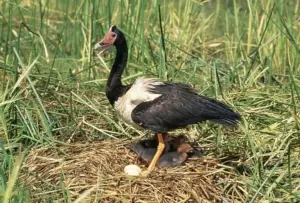
The nest-building process itself is a cooperative effort between male and female magpie geese. They typically begin constructing the nest approximately two months prior to laying eggs, instrumental in setting up a safe space for the eventual arrival of their goslings. A single female may lay a clutch of eggs varying from five to 14, spaced out over 24 to 36 hours. The shared responsibilities of incubation are fascinating, as both parents take turns sitting on the clutch, showcasing their level of cooperation. This bonding behavior reinforces pair relationships an important aspect of their breeding dynamics.
Once the eggs hatch generally after an incubation period of 23 to 30 days the newly hatched goslings are quick to leave the nest, a trait characteristic of many waterfowl species. The adults continue to care for the young, guiding them to water and foraging grounds where they can begin to feed. This cooperative breeding behavior enhances chick survival rates in environments that are often dangerous due to the presence of predators.
In summary, the nesting and breeding behaviors of the magpie goose encapsulate the essence of their social structure, emphasizing the importance of community and cooperation in raising their young. This intricate relationship between parents reflects an evolved process shaped by the need to protect and nurture future generations amid the challenges posed by their wetland habitats.
Social Structure
The social structure of the magpie goose (Anseranas semipalmata) is a fascinating aspect that encompasses their behaviors, relationships, and communal dynamics. Renowned for their gregarious nature, these birds often form large flocks sometimes numbering thousands of individuals especially outside of breeding seasons.
Within these flocks, magpie geese display complex social interactions, enhanced by vocal communications that serve to alert others about potential threats or coordinate movement. The sound of their honking fills the air, creating an engaging environment full of activity. This vocal repertoire not only plays a significant role in maintaining cohesion within the flock but also fosters a sense of community among the geese.
During the breeding season, magpie geese adopt a more organized social structure, often nesting in communal groups. These nesting colonies comprise various pairs that collectively work towards protecting their eggs and young from predators. Generally, one male may mate with multiple females as part of a booming social hierarchy that enhances cooperative breeding. This fluid social framework allows for shared responsibilities in breeding, which can lead to higher survival rates of chicks, underscoring the adaptive advantages of such strategies.
Social interactions among magpie geese can also be influenced by environmental factors, food availability, and changes in habitat. For instance, during the dry season, some individuals may disperse into agricultural fields or urban landscapes, demonstrating the species’ adaptability to different habitats while still maintaining connections within the broader social structure.
Overall, the social structure of the magpie goose illustrates an intricate dynamic built on cooperation, communication, and adaptability. By examining these social behaviors and relationships, we can gain a deeper appreciation for the species and the biological and ecological significance of their interactions within diverse wetland environments.
Conservation Status of the Magpie Goose
The magpie goose is classified as ‘Least Concern’ on the IUCN Red List due to its large and stable population. Its range covers about 5,050,000 km², offering some assurance of its survival despite environmental pressures.
However, local conservation challenges remain considerable, particularly in southern and southeastern Australia. In these regions, some populations of the magpie goose face significant threats, leading to varying conservation classifications across Australian states. Notably, it is deemed “endangered” in Victoria and South Australia, while it is classified as “vulnerable” in New South Wales. Conversely, populations in the Northern Territory, Queensland, and Western Australia remain “secure,” highlighting the spatial variability in their conservation statuses.
Key threats affecting magpie goose populations include habitat loss and degradation predominantly resulting from agricultural expansion, changes in water management, and urban development. Additionally, while hunting has historically formed an essential aspect of Indigenous practices, commercial hunting contributes to localized population declines.
Despite these issues, the overall stability of the magpie goose population at a broader scale supports its classification as least concern. The ongoing monitoring of regional populations and habitats is essential, not only to guide policy decisions but also to inform conservation strategies aimed at safeguarding key habitats.
In sum, while the magpie goose enjoys a general status of being least concerned, localized conservation issues underpin the need for targeted management approaches. Protecting their habitats from loss and degradation, while incorporating sustainable practices, is vital for ensuring the ongoing survival of this culturally and ecologically significant species.
Endangered Status Reasons
Several factors contribute to the endangered status of the magpie goose (Anseranas semipalmata) in certain regions. While the species as a whole is classified as “Least Concern” on the IUCN Red List, there are localized populations that face significant conservation challenges. Understanding these threats is vital for implementing effective management strategies.
- Habitat Loss and Degradation: The primary threat to the magpie goose is the conversion of wetlands for agriculture, urban development, and other land uses. As wetlands are drained or altered, the habitats necessary for breeding, feeding, and nesting are severely compromised, limiting the available resources for the species.
- Changes in Water Management: In many areas, modified water management practices have negatively impacted wetland ecosystems crucial for the magpie goose’s survival. Altered water flow patterns influence flooding and drying cycles, leading to habitat degradation and reduced access to vital food and nesting resources.
- Hunting Pressures: While hunting has been a culturally significant activity among Indigenous Australians, commercial hunting poses a threat to localized populations of magpie geese. Managers and conservationists must strike a balance between cultural practices and species conservation, ensuring sustainable hunting without compromising population viability.
- Climate Change: The anticipated impacts of climate change introduce an additional layer of complexity to the threats facing the magpie goose. Rising sea levels pose risks of inundation to wetland habitats, while changes in seasonal rainfall patterns can disrupt the delicate balance that sustains these ecosystems.
- Invasive Species: The encroachment of non-native aquatic plants and species can crowd out the native flora and fauna essential for the survival of magpie geese. This ecological pressure can alter feeding patterns and habitat availability, compounding the challenges presented by habitat loss.
Overall, the endangered status reasons for the magpie goose underscore the complexity of conservation efforts. Recognizing localized population pressures even in species deemed least concern highlights the ongoing need for targeted care and management strategies that address the challenges posed by habitat loss, hunting, climate change, and invasive species.
Current Conservation Efforts
Conservation efforts for the magpie goose (Anseranas semipalmata) are multi-faceted and focus on both habitat protection and incorporating Indigenous knowledge. Recent initiatives have shown promise in mitigating threats while fostering a collaborative approach to conservation.
- Habitat Protection and Restoration: One essential pillar of conservation is the effective safeguarding of wetland habitats. Strategies to restore and protect existing habitats are currently being explored, ensuring that magpie geese have access to undisturbed breeding and foraging grounds. Fostering agreements between landholders and conservation organizations is vital for achieving tangible conservation outcomes.
- Community Involvement: Engaging Indigenous communities in conservation efforts is integral to success. Traditional ecological knowledge serves as a valuable resource in managing local ecologies sustainably. Collaborative programs where local communities monitor magpie goose populations and habitats empower them to take an active role in protecting traditional practices and the ecosystems that support their cultural heritage.
- Research Initiatives: Ongoing research into the magpie goose’s feeding behavior, habitat preferences, and population dynamics informs conservation strategies. By understanding the ecological needs of magpie geese, researchers can promote effective habitat management practices while anticipating changes driven by human impacts and environmental stressors.
- Monitoring Programs: Comprehensive monitoring of magpie goose populations is vital to assess their health and the effectiveness of conservation efforts. Using advanced ecological modeling techniques can provide important insights into population dynamics and habitat use, guiding future management interventions.
- Education and Awareness Campaigns: Raising awareness about the ecological importance of the magpie goose and the threats it faces can galvanize public action and support for conservation initiatives. Through community outreach and educational programs, stakeholders can foster a greater appreciation for the species and promote engagement in conservation activities.
In summary, current conservation efforts targeting the magpie goose aim to enhance habitat protection, engage communities, expand research initiatives, and promote awareness. Integrating scientific research with traditional cultural practices strengthens protective measures, ensuring that this remarkable species receives the attention it deserves in the broader context of conservation.
Threats to Survival
The magpie goose (Anseranas semipalmata) faces a myriad of threats that jeopardize its survival in various regions, highlighting the complexities and challenges of conservation. Understanding these threats is essential for developing effective strategies to protect this vital species and its wetland habitats.
- Habitat Loss: One of the most pressing threats to the magpie goose is the ongoing loss of wetland habitats due to agricultural expansion, urban development, and industrial activities. Wetland drainage for irrigation and land use significantly reduces the available breeding and feeding grounds, impeding the species’ ability to thrive in its natural environment.
- Climate Change: The impacts of climate change present significant challenges to the sustainability of wetland habitats. Rising sea levels threaten to inundate coastal wetlands, which is particularly concerning for populations in northern Australia. Over time, these changes can lead to increased salinity, altering the vegetation composition crucial for foraging and nesting.
- Hunting: While traditional hunting has been a sustainable practice among Indigenous communities, commercial hunting poses additional pressure on local magpie goose populations. Unsustainable hunting practices can lead to localized declines, particularly in areas where population numbers are already vulnerable.
- Invasive Species: The introduction of non-native species can disrupt the ecological balance within wetlands, competing for resources and altering habitats essential for the magpie goose. Invasive aquatic plants can crowd out native vegetation, limiting food availability and breeding opportunities.
- Water Management Practices: Changes in water management policies, particularly those that affect flood regimes and natural water cycles, can lead to habitat degradation. Altered flow patterns can reduce the extent of wetlands during critical seasons, affecting food availability and breeding success.
Overall, the threats to the survival of the magpie goose underscore the need for ongoing monitoring and adaptive management. By addressing these challenges collectively through habitat protection, sustainable hunting practices, and proactive responses to climate change conservationists can help ensure the ongoing survival of the magpie goose and its vital ecosystems.
Cultural Significance of the Magpie Goose
The cultural significance of the magpie goose (Anseranas semipalmata) extends well beyond its appearances in wetlands. For the Indigenous peoples of northern Australia, this bird plays a central role in traditional practices, ecological knowledge, and community identity.
- Traditional Food Source: The magpie goose serves as a crucial food source for various Indigenous communities, supplying both sustenance and cultural value. The harvesting of magpie geese is often tightly interwoven with seasonal cycles and traditional practices, providing a vital connection to their land and heritage.
- Cultural Symbolism: Within Aboriginal culture, the magpie goose is viewed as a symbol of absence and abundance, deeply tied to the wetter environments that support both the bird and community lifestyles. Its qualities resonate in ceremonies and stories, embodying themes of life and connection to the earth.
- Habitat Health Indicators: The presence and population health of magpie geese are often seen as indicators of the overall health of wetland ecosystems. Indigenous communities closely observe these dynamics, allowing for insights into environmental changes, which guide their resource management practices.
- Customary Practices: The customary harvesting methods employed by Indigenous Australians reflect deep ecological knowledge and respect for the magpie goose. There are established protocols surrounding hunting, cooking, and distribution that embody cultural traditions and spiritual beliefs.
- Impact of Environmental Change: Climate change and habitat destruction pose risks not only to the magpie goose but also to its cultural significance. As wetland habitats face threats, the livelihoods and cultural practices linked to this bird also suffer, highlighting how closely ecology and culture are interconnected.
In summary, the magpie goose holds a vital cultural significance among Indigenous peoples, embodying an essential relationship between community, sustenance, and ecological health. Its presence in traditional practices and narratives underscores the deep connections that Indigenous Australians maintain with their environment.
Role in Aboriginal Culture
The magpie goose holds deep significance in Aboriginal culture, blending tradition, spirituality, and sustenance. It is a vital food source and symbolizes the close connection between Indigenous people and their land.
- Cultural Keystone Species: The magpie goose is recognized as a cultural keystone species, integral to the rituals, practices, and lifestyles of many Aboriginal groups. Celebrated in oral traditions, songs, and art, the bird symbolizes both fertility and abundance, reinforcing the importance of wetland ecosystems in cultural narratives.
- Food Security and Tradition: Historically, the magpie goose has been relied upon for nourishment, forming an essential part of traditional diets. The sustainable harvesting of this species reflects not only practical needs but also deep spiritual practices connected to seasonal cycles and land stewardship.
- Ecological Wisdom: Indigenous peoples possess profound ecological knowledge rooted in centuries of observation. The behaviors and population trends of magpie geese provide insights into the health of their wetland habitats, guiding sustainable practices that align with traditional resource management.
- Symbolism in Art and Ceremony: The magpie goose frequently appears in Indigenous art, representing more than just a source of food; it embodies stories and teachings that inform cultural identity. Such representations serve to connect younger generations to their heritage while educating others about the significance of biodiversity.
- Challenges from Environmental Changes: The cultural significance of the magpie goose is increasingly threatened by environmental changes, such as climate variability and habitat loss. As wetlands are altered, the traditional practices associated with the goose are jeopardized, prompting concerns within Indigenous communities and conservationists alike.
Ultimately, the role of the magpie goose in Aboriginal culture exemplifies the interconnectedness of identity, sustainability, and ecological awareness. Its significance extends beyond mere sustenance, illustrating the rich tapestry of beliefs and practices that define Indigenous relationships with their environment.
Representation in Art and Literature
The magpie goose (Anseranas semipalmata) serves as a symbolic and meaningful presence in both art and literature within Australian culture. Its striking appearance and ecological dynamics have inspired various representations that capture its essence, value, and significance in diverse contexts.
- Indigenous Art: In Indigenous Australian culture, the magpie goose is not merely a subject; it embodies connections to land, resources, and community identity. Traditional Aboriginal artwork often features the imagery of the magpie goose, portraying its distinctive coloration and graceful form. These depictions serve as a powerful reminder of the species’ role in cultural traditions and environmental stewardship.
- Themes in Literature: In literature, the magpie goose is often associated with themes of resilience and adaptability. Stories featuring this bird frequently illustrate its cleverness and ability to navigate the challenges of its environment, mirroring the tenacity found within the Indigenous cultures that revere it. This symbolism resonates within narratives of survival and adaptation, informing broader discussions about ecological balance and persistence.
- Cultural Folklore: The magpie goose appears in various folklore narratives where it may serve as a character illustrating lessons related to the environment, community, and resource conservation. These tales not only entertain but also educate young generations about the significance of respecting nature and understanding wildlife.
- Modern Artistic Inspirations: Contemporary artists continue to draw inspiration from the magpie goose, utilizing its imagery in paintings, sculptures, and multimedia works. The contrasting black and white plumage inspires discussion about duality, balance, and the interconnectedness of life in wetlands, promoting a deeper awareness of ecological themes within modern audiences.
- Conservation Awareness: The representation of the magpie goose in art and literature also serves as a platform for raising awareness about conservation challenges. By illustrating the beauty and significance of this species, artists and writers contribute to broader movements focused on habitat protection and sustainability efforts.
In summary, the magpie goose stands as a prominent figure in art and literature, celebrating its ecological role while emphasizing its cultural significance. Through various artistic expressions, the goose serves as a bridge connecting traditional knowledge with modern narratives, fortifying its relevance in a rapidly changing world.
Research and Studies on the Magpie Goose
Research on the magpie goose (Anseranas semipalmata) offers valuable insights into its ecology, behavior, and conservation requirements. Studies conducted over the years have unveiled critical information regarding population dynamics, habitat utilization, and the role of this species in the broader ecosystem.
- Population Dynamics: A comprehensive study conducted from 1984 to 1987 highlighted how seasonal rainfall patterns significantly influence the population dynamics of magpie geese in northern Australia. The research established correlations between wetland density and the presence of foraging flocks, underscoring the necessity of healthy ecosystems for sustaining magpie goose populations.
- Habitat Use and Seasonal Trends: An extensive review of aerial surveys spanning 25 years (1981-2006) in the Kakadu region provided insights into how magpie geese shift their habitats in response to seasonal changes. The study revealed how habitat distribution varies with rainfall patterns, demonstrating the intricate link between environmental conditions and population trends.
- Aboriginal Ecological Knowledge: Recent studies have highlighted the importance of traditional ecological knowledge within Aboriginal communities. This knowledge plays a vital role in understanding magpie goose behaviors and habitat requirements. Researchers are increasingly integrating Indigenous perspectives into management recommendations, showcasing a holistic approach to conservation.
- Impact of Environmental Changes: Ongoing research examines the pressing threats facing magpie goose populations, particularly regarding climate change and habitat degradation. Findings indicate that understanding the complex interactions between these threats is crucial for developing effective conservation and management strategies.
- Baseline Understanding for Management: Studies of magpie goose movements and dietary preferences are foundational for informing conservation plans. As scientists document these dynamics, findings become essential tools for habitat conservation and addressing potential human-wildlife conflicts, particularly in agricultural landscapes.
In conclusion, the research and studies focused on the magpie goose underscore the importance of ongoing investigations into their ecological dynamics. These insights elucidate the relationship between the species and its environment and inform conservation practices, ensuring the sustainability of this culturally and ecologically significant bird.
Recent Findings
Recent findings regarding the magpie goose (Anseranas semipalmata) have shed light on various aspects of its ecology, behavior, and the challenges it faces from environmental change. Researchers have pursued numerous avenues of inquiry, resulting in insightful conclusions that support ongoing conservation efforts.
- Feeding Behavior and Agricultural Impact: A study by Charles Darwin University found that magpie geese feed opportunistically, especially during the late dry season when agricultural areas are accessible. While they don’t target crops specifically, their feeding often overlaps with farmland, indicating a need for strategies to reduce conflicts with farmers.
- Cultural and Ecological Significance: Research shows that magpie geese are important both ecologically and culturally. They serve as a vital food source and provide insights into wetland ecosystem health, which is crucial for Indigenous communities’ sustenance and cultural practices.
- Impact of Climate Change: CSIRO research highlights concerns about rising sea levels affecting magpie goose habitats. By 2070, up to 42% of freshwater wetlands might be inundated with saltwater, reducing nesting and foraging areas. This underscores the need for adaptive management strategies to address these environmental challenges.
- Population Dynamics and Future Conservation Strategies: Population models developed for magpie geese consider spatial and temporal variations in habitat use. These models enhance our understanding of population dynamics, thus guiding effective conservation strategies that address predicted future changes.
Ultimately, these recent findings underscore the importance of continued research and adaptive management to ensure the sustainability of magpie goose populations. With their ecological and cultural significance, understanding the challenges that impact this species and its habitat is imperative for successful conservation efforts.
Importance to Ecosystem
The magpie goose (Anseranas semipalmata) plays a pivotal role within its ecosystem, particularly in wetland environments. This species is not only a remarkable example of adaptation to diverse habitats but also serves as a valuable component contributing to the overall health of its ecosystem.
- Nutrient Cycling: As herbivores feeding on various aquatic plants and grasses, magpie geese play an essential role in nutrient cycling within wetland ecosystems. Their foraging activities help to regulate the growth of specific plant species, preventing overgrowth and ensuring balanced plant communities that support various wildlife.
- Prey for Predators: Magpie geese also act as a food source for predators within their habitat. By providing sustenance to apex predators, these geese contribute to the food web and play a vital role in maintaining ecological balance.
- Indicators of Habitat Quality: The presence and health of magpie goose populations can serve as indicators of wetland ecosystem quality. When populations thrive, this often reflects healthy aquatic ecosystems, with adequate food resources and suitable habitats. Conversely, declines in their numbers may signify underlying ecological issues that require attention.
- Engagement in Ecosystem Dynamics: During the breeding season, magpie geese form large colonies, highlighting their social behaviors in wetland ecosystems. These gatherings boost breeding success and influence vegetation around nesting sites, underscoring their role in environmental dynamics.
- Cultural and Biodiversity Significance: As a culturally significant species for Indigenous communities, the conservation of magpie geese is tied to broader biodiversity efforts that encompass various plant and animal life within wetland ecosystems. Their protection fosters healthy habitats for myriad species, enhancing overall ecological diversity.
In summary, the magpie goose holds multifaceted significance within its ecosystem, ensuring the continued health of wetland environments and serving as indicators of ecological change. By recognizing its importance, conservation efforts aimed at preserving this species and its habitat contribute to the broader goals of maintaining ecological integrity and biodiversity.
Population Studies and Trends
Population studies and monitoring of the magpie goose (Anseranas semipalmata) are crucial for understanding its dynamics within wetland ecosystems. Research conducted over the years has revealed valuable insights into their population trends, habitat use, and potential threats.
- Monitoring Objectives: Various studies aim to monitor the population of magpie geese to gain insights into changes that occur over time in response to environmental fluctuations and human activities. Assessing the size and stability of populations is essential for detecting trends that may inform conservation efforts.
- Seasonal Variations: A study in northern Australia examined how seasonal rainfall affected magpie goose distribution and numbers over several years. The findings reveal that wet conditions are linked to increased populations, showing the species’ reliance on specific wetland conditions for survival.
- Long-Term Surveys: Aerial surveys in Kakadu National Park from 1981 to 2006 revealed population trends and habitat use of magpie geese. The studies showed how rainfall and climate fluctuations affect their numbers, highlighting the link between environmental conditions and population dynamics.
- Cultural Significance and Implications: Research has noted the cultural significance of magpie geese and the implications of any population declines on Indigenous communities. Understanding these trends is crucial for integrating conservation objectives with socio-cultural needs, ensuring the preservation of both ecological and cultural heritage.
- Adaptation to Environmental Changes: Recent studies have focused on how magpie geese may adapt to changing environmental conditions. This involves investigating potential shifts in habitat use, dietary preferences, and breeding behaviors, all of which are vital for predicting population responses and determining effective management strategies.
In conclusion, ongoing studies and monitoring of the magpie goose are crucial for understanding its role in wetland ecosystems. Researchers can use population trends and influencing factors to guide conservation practices and improve efforts to protect this species.
